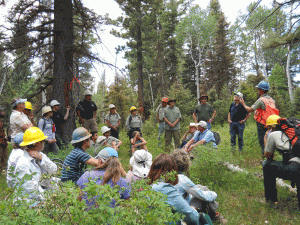
WCC members participated in an Uncompahgre Project field trip in July, during which the SBEADMR was a central topic of discussion. (Emily Hornback photo)
by Emily Hornback, WCC Organizer
Last year, the US Forest Service initiated a large “treatment plan” for the Grand Mesa, Uncompahgre and Gunnison (GMUG) National Forests called the “Spruce Beetle Epidemic and Aspen Decline Management Response” or SBEADMR.
SBEADMR was originally proposed as a plan to address forest health issues related to beetle kill, Sudden Aspen Decline (SAD) syndrome, and to prepare the forest for climate change impacts. However, as WCC and allies have engaged with this process over the past year, we have come to find that the devil really is in the details.
This project proposes to treat between 70,000-120,000 acres of mixed spruce and aspen forest over a 10 year period with a combination of commercial mechanical logging and non-commercial mechanical treatments ranging from hand-cutting to prescribed burning. Although this is a large number of acres, it represents only 3% of the GMUG.
After submitting detailed comments and concerns during the scoping period, participating in many collaborative meetings and some on-the-ground field trips to the Uncompahgre Plateau, the conservation community has flagged a number of concerns with the project, ranging from wildlife issues (such as lynx habitat) to inadequate analysis of the carbon sequestration values of living forests.
While WCC understands the desire to act in the face of massive tree die off due to beetles and SAD, we are concerned that the Forest Service is rushing into this action using climate change and wildfire concerns as the rational when, in fact, the purpose of the project is to remove dead and dying trees (also known as salvage logging) to supply a Montrose mill.
WCC is supportive of sensible logging to provide economic benefit to local communities, and believes there are appropriate places to cut trees to protect public safety and infrastructure. The Forest Service has said that there is adequate timber in the “wildland urban interface” to supply this project. However we don’t want to hand the agency a blank check for the next 10 years without a strong plan for monitoring the impacts of treatments and for ongoing public involvement in the site-specific project implementation.
Since the Forest Service is conducting this project through an “enhanced NEPA” process that is allowing public comment before the Draft EIS is published, there is still time to influence SBEADMR and ensure our concerns are addressed.
The next opportunity will be a “Forest Heath & Management Science Workshop” on August 19, which will bring together top forest scientists from across the West to discuss the project. The discussion at the meeting will be used to inform the SBEADMR Draft EIS. The workshop will then be followed up with a field trip to the Gunnison Ranger District to see on-the-ground treatments and impacts on September 4.
We encourage anyone interested public land and forest management to attend both of these events! For more information, please contact Emily Hornback, [email protected], 970-256-7650.
The Forest Service will be accepting comments on SBEADMR until September 1, 2014.
